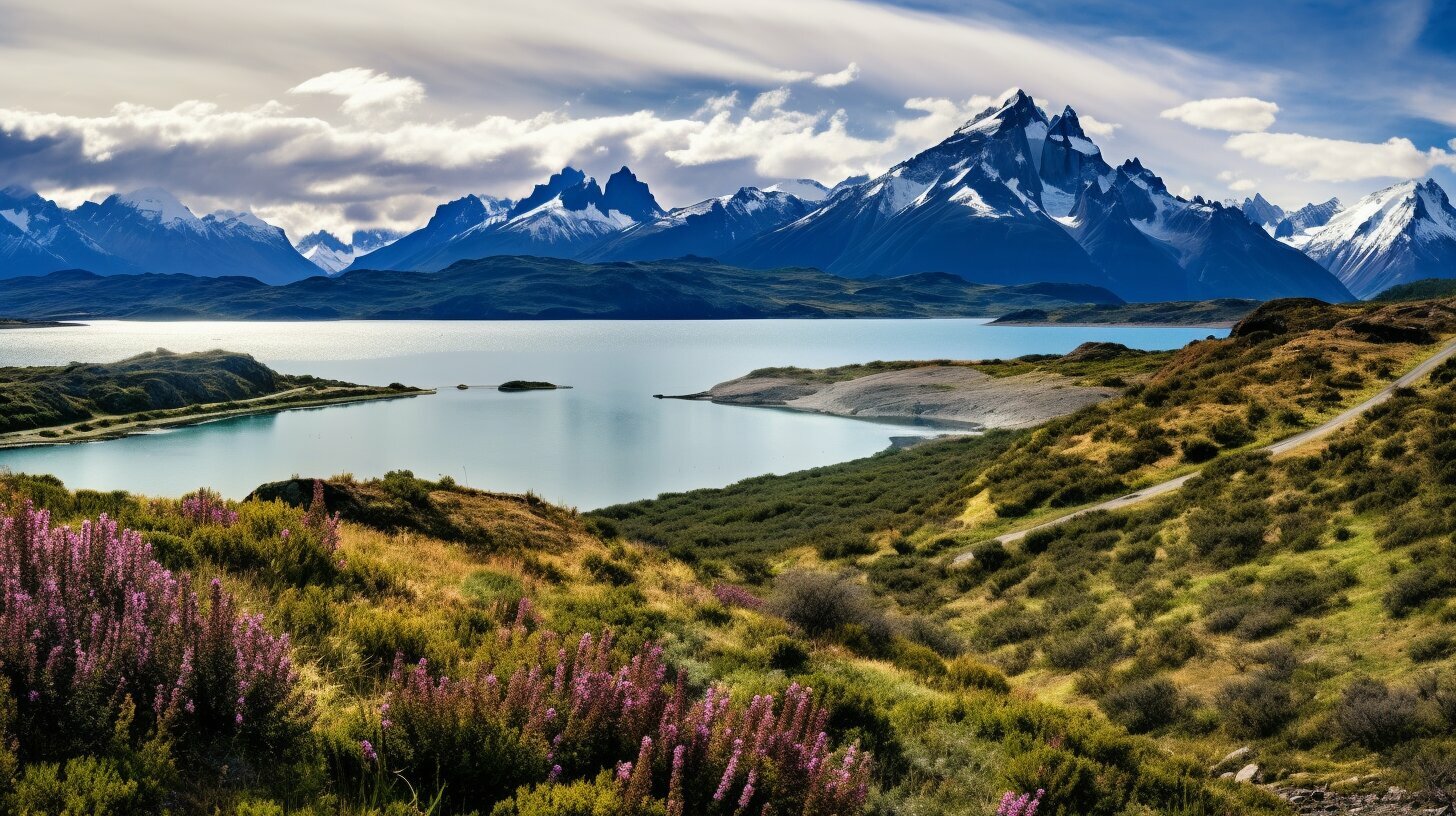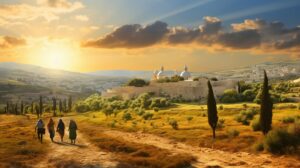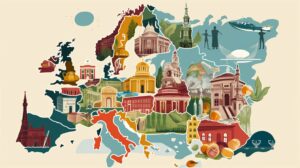Patagonia is a beautiful and remote region located at the southern end of South America, spanning across two countries. It is governed by both Argentina and Chile. The region is bounded by the Pacific Ocean to the west, the Atlantic Ocean to the east, and various bodies of water that connect them. The northern limit of Argentine Patagonia is considered to be the Colorado and Barrancas rivers, while the northern limit of Chilean Patagonia is located at the Huincul Fault. Patagonia is known for its diverse geography, including mountains, lakes, fjords, deserts, and steppes.
The economy of eastern Patagonia is centered around sheep farming and oil and gas extraction, while fishing, aquaculture, and tourism dominate in western Patagonia. Patagonia has a rich cultural heritage, influenced by Criollo, Mestizo, Indigenous, and various European groups including German, Croat, Italian, English, Scot, and Welsh communities.
Key Takeaways:
- Patagonia is located at the southern end of South America, spanning across Argentina and Chile.
- The region is characterized by diverse geography, including mountains, lakes, fjords, deserts, and steppes.
- The economy of Patagonia is driven by sheep farming, oil and gas extraction, fishing, aquaculture, and tourism.
- Patagonia has a rich cultural heritage influenced by Criollo, Mestizo, Indigenous, and European groups.
- It is a remote and beautiful region that offers a unique experience for travelers.
The Geographic Location of Patagonia
Patagonia is bounded by the Pacific Ocean to the west, the Atlantic Ocean to the east, and is governed by both Argentina and Chile. This vast region, located at the southern end of South America, is renowned for its breathtaking natural beauty and unique geographical features. From towering mountains and expansive lakes to rugged deserts and picturesque fjords, Patagonia offers a diverse landscape that captivates visitors from around the world.
The northern limit of Argentine Patagonia is marked by the Colorado and Barrancas rivers, while the northern boundary of Chilean Patagonia lies along the Huincul Fault. These demarcations separate the region into two distinct parts, each with its own distinct characteristics and attractions.
In eastern Patagonia, which falls within Argentina, the economy revolves around sheep farming and oil and gas extraction. The vast expanses of open plains and fertile grasslands make it an ideal location for sheep farming, which has been a traditional livelihood in the region for centuries. Additionally, the presence of oil and gas reserves has spurred economic growth and development.
On the other hand, western Patagonia, which lies within Chile, is characterized by a strong focus on fishing, aquaculture, and tourism. The pristine waters of the Pacific Ocean provide abundant marine resources, making fishing a significant industry in this part of Patagonia. The region’s breathtaking landscapes and natural wonders, such as the famous Torres del Paine National Park, attract travelers seeking outdoor adventures and eco-tourism experiences.
| Country | Main Industries |
|---|---|
| Argentina | Sheep farming, oil and gas extraction |
| Chile | Fishing, aquaculture, tourism |
Patagonia also boasts a rich cultural heritage shaped by diverse communities. Criollo and Mestizo influences, along with Indigenous traditions, contribute to the region’s vibrant cultural tapestry. Moreover, various European groups, including German, Croat, Italian, English, Scot, and Welsh communities, have also played a significant role in shaping Patagonia’s identity.
In conclusion, Patagonia is a fascinating region located at the southern end of South America, encompassing both Argentina and Chile. Its geographical marvels, economic activities, and cultural diversity make it a destination like no other. Whether exploring the dramatic landscapes or immersing oneself in the unique cultural heritage, Patagonia offers an unforgettable experience for travelers seeking adventure, natural beauty, and cultural enrichment.
Patagonia in Argentina
Argentine Patagonia is considered to have its northern limit at the Colorado and Barrancas rivers, and it is known for its diverse geography. This region of Patagonia boasts stunning landscapes that range from towering snow-capped mountains to expansive deserts. The iconic Andes mountain range runs along the western border, forming a natural boundary between Argentina and Chile.
One of the standout features of Argentine Patagonia is the presence of numerous glacial lakes. These crystal-clear bodies of water, such as Lake Nahuel Huapi and Lake Argentino, offer breathtaking views and provide ample opportunities for outdoor activities like kayaking, fishing, and hiking.
Additionally, the region is home to the famous Los Glaciares National Park, which is a UNESCO World Heritage site. This park encompasses the impressive Perito Moreno Glacier, known for its massive ice formations and dramatic calving events. It is a popular tourist destination, attracting visitors from around the world who come to witness the awe-inspiring beauty of this natural wonder.
| Key Features of Argentine Patagonia | Location | Popular Attractions |
|---|---|---|
| Gorgeous glacial lakes | Located in southern Argentina | Lake Nahuel Huapi, Lake Argentino |
| Andes mountain range | Forms the western border | Mount Fitz Roy, Cerro Torre |
| Los Glaciares National Park | UNESCO World Heritage site | Perito Moreno Glacier, Mount Fitz Roy |
Exploring Argentine Patagonia
When visiting Argentine Patagonia, travelers have the opportunity to immerse themselves in its unique culture and experience the warmth of its people. The region is known for its rich history, influenced by Indigenous communities and European settlers.
“The stunning landscapes of Argentine Patagonia, from its glacial lakes to towering mountains, offer an unforgettable experience for nature enthusiasts and adventure seekers alike.” – Travel Magazine
Whether it’s trekking through the iconic mountains, witnessing the power of the glaciers, or simply indulging in the local cuisine, Argentine Patagonia offers a wealth of experiences that cater to all interests. It is a destination that truly captures the imagination and leaves a lasting impression on all who visit.
Patagonia in Chile
Chilean Patagonia has its northern limit located at the Huincul Fault, and it boasts stunning landscapes and unique natural formations. This region of Patagonia is known for its breathtaking fjords, towering mountains, and expansive glaciers, drawing in travelers from around the world. One of the most iconic sites in Chilean Patagonia is Torres del Paine National Park, a UNESCO World Heritage site that offers unparalleled opportunities for hiking, wildlife spotting, and immersing oneself in nature.
The rugged beauty of Chilean Patagonia is further accentuated by the presence of picturesque lakes, such as General Carrera Lake, which is the largest lake in Chile and offers mesmerizing turquoise waters. The region is also home to numerous islands, including the Chiloé Archipelago, known for its distinct culture and vibrant wooden churches.
The Unique Wildlife of Chilean Patagonia
Chilean Patagonia is a haven for wildlife enthusiasts, with a diverse range of species thriving in its pristine habitats. One of the notable inhabitants of the region is the South Andean deer, also known as the huemul. This species is considered a national symbol of Chile and can be spotted in certain areas of Patagonia. Other indigenous wildlife includes the South American gray fox and the elusive puma.
“Chilean Patagonia is a place where nature takes center stage, offering an awe-inspiring experience for those who venture into its untouched wilderness.”
Exploring the remote corners of Chilean Patagonia reveals hidden treasures such as the Marble Caves, a collection of stunning caves carved by General Carrera Lake over thousands of years. These natural marvels showcase the power of water and time, resulting in intricate patterns and vibrant colors that will leave visitors in awe.
Table: Notable Natural Landmarks in Chilean Patagonia
| Landmark | Description |
|---|---|
| Torres del Paine | A world-renowned national park known for its majestic granite peaks and pristine lakes. |
| General Carrera Lake | The largest lake in Chile, famous for its mesmerizing turquoise waters. |
| Chiloé Archipelago | A group of islands known for their unique culture, wooden churches, and beautiful landscapes. |
| Marble Caves | Spectacular caves formed by the erosion of General Carrera Lake, displaying stunning patterns and vibrant colors. |
Chilean Patagonia is a place where nature takes center stage, offering an awe-inspiring experience for those who venture into its untouched wilderness. Whether exploring its majestic national parks, marveling at its natural formations, or encountering its unique wildlife, this region of Patagonia leaves an indelible mark on all who visit.
Economic Activities in Patagonia
The economy of Patagonia is characterized by various industries, with sheep farming and oil and gas extraction being prominent in the eastern region. The vast open landscapes and fertile grasslands provide ideal conditions for sheep farming, which has been a traditional economic activity in Patagonia for centuries. The region is known for its high-quality wool, and sheep farming has become an integral part of Patagonian culture.
Oil and gas extraction is another significant industry in eastern Patagonia. The region possesses vast reserves of hydrocarbons, and exploration and production activities contribute significantly to the local economy. Patagonia’s oil and gas fields are vital for energy production in Argentina, making the region strategically important for the country’s energy sector.
In western Patagonia, fishing, aquaculture, and tourism play a crucial role in the economy. The region is blessed with abundant marine resources, including a variety of fish species, crustaceans, and mollusks. Fishing is a traditional activity in coastal communities, with commercial fleets bringing in fresh catches daily. Additionally, the development of aquaculture has gained momentum in recent years, with salmon farming being one of the key sectors.
Tourism also contributes significantly to the economy of western Patagonia. The region’s natural beauty, including glaciers, fjords, and national parks, attracts visitors from all over the world. Adventure tourism, hiking, wildlife spotting, and glacier tours are popular activities for tourists exploring the breathtaking landscapes of Patagonia.
Summary
In summary, Patagonia’s economy thrives on a diverse range of industries. Sheep farming and oil and gas extraction are prominent in the eastern region, while fishing, aquaculture, and tourism dominate in the western part. The unique combination of natural resources and cultural heritage makes Patagonia not only a fascinating region but also an economic powerhouse in South America.
| Economic Activities | Region |
|---|---|
| Sheep farming | Eastern Patagonia |
| Oil and gas extraction | Eastern Patagonia |
| Fishing | Western Patagonia |
| Aquaculture | Western Patagonia |
| Tourism | Western Patagonia |
Cultural Heritage of Patagonia
Patagonia boasts a rich cultural heritage, shaped by the blending of Criollo, Mestizo, Indigenous, and European traditions and communities. This unique fusion of cultures has resulted in a vibrant and diverse tapestry of customs, languages, art, music, and cuisine. Let’s delve deeper into the fascinating cultural heritage of this enchanting region.
Indigenous Communities
The Indigenous peoples of Patagonia have inhabited the region for thousands of years, each with their distinct traditions and languages. The Mapuche, Tehuelche, and Selk’nam are among the indigenous groups that have left an indelible mark on the cultural landscape. Their deep connection with the land and nature is reflected in their spiritual beliefs, traditional rituals, and art forms.
European Influences
The arrival of European settlers in the 19th century brought further diversity to Patagonia’s cultural fabric. Immigrants from Germany, Croatia, Italy, England, Scotland, and Wales flocked to Patagonia, seeking new opportunities and a better life. These European communities contributed to the region’s architecture, agriculture, language, and customs, creating a blend of Old World traditions in the heart of South America.
| European Communities in Patagonia | Contributions |
|---|---|
| German | Establishment of agricultural colonies, beer brewing, traditional festivals |
| Croat | Sheep farming, viticulture, traditional dances |
| Italian | Culinary traditions, winemaking, architecture |
| English | Sheep farming, railroads, English tea culture |
| Scottish | Sheep farming, bagpipe music, Scottish Highland Games |
| Welsh | Sheep farming, choral music, Welsh-language traditions |
Criollo and Mestizo Heritage
Patagonia is also influenced by the Criollo and Mestizo communities, who trace their roots back to the time of Spanish colonization. Criollo refers to people of Spanish descent born in the Americas, while Mestizo signifies individuals of mixed European and Indigenous heritage. These communities have contributed to Patagonia’s folklore, traditional clothing, music, and dance, bringing a unique blend of Latin American and European influences.
In conclusion, the cultural heritage of Patagonia is a vibrant mosaic that reflects the diverse backgrounds and traditions of its inhabitants. From Indigenous communities deeply connected to the land, to the European settlers who brought their own customs and languages, Patagonia is a living testament to the power of cultural exchange and adaptation. Exploring this rich tapestry of heritage adds another layer of enchantment to the breathtaking landscapes of this captivating region.
Conclusion
In conclusion, Patagonia is a breathtaking region spanning across Argentina and Chile, with diverse geography, economic activities, and a rich cultural heritage. Located at the southern end of South America, Patagonia is governed by both Argentina and Chile, and is bounded by the Pacific Ocean to the west and the Atlantic Ocean to the east. This unique region boasts a variety of landscapes, including mountains, lakes, fjords, deserts, and steppes, making it a haven for nature lovers and adventure seekers.
The economy of eastern Patagonia revolves around sheep farming and oil and gas extraction, while the western part of the region is characterized by fishing, aquaculture, and tourism. With vast open spaces, pristine lakes, and stunning coastal areas, Patagonia offers a wide range of outdoor activities such as hiking, skiing, fishing, and wildlife spotting. Its natural beauty combined with its rich cultural heritage makes it a captivating destination for travelers from around the world.
The cultural heritage of Patagonia is influenced by a diverse mix of communities, including Criollo, Mestizo, Indigenous, and European groups. Communities of German, Croat, Italian, English, Scot, and Welsh descent have contributed to the cultural fabric of the region, adding depth and diversity to its traditions, cuisine, and festivals. This multicultural heritage is evident in the architecture, music, dance, and arts of Patagonia, creating a vibrant and dynamic cultural scene.
Whether you are seeking adventure in the great outdoors, exploring unique landscapes, or immersing yourself in a rich cultural tapestry, Patagonia offers an unforgettable experience. With its stunning natural beauty, thriving economic activities, and vibrant cultural heritage, Patagonia truly stands as a testament to the wonders of this remarkable region.
FAQ
Q: What country is Patagonia in?
A: Patagonia is located at the southern end of South America and is governed by both Argentina and Chile.
Q: What is the geographic location of Patagonia?
A: Patagonia is bounded by the Pacific Ocean to the west, the Atlantic Ocean to the east, and various bodies of water that connect them.
Q: What is Patagonia known for?
A: Patagonia is known for its diverse geography, including mountains, lakes, fjords, deserts, and steppes.
Q: What are the main economic activities in Patagonia?
A: The economy of eastern Patagonia is centered around sheep farming and oil and gas extraction, while fishing, aquaculture, and tourism dominate in western Patagonia.
Q: What is the cultural heritage of Patagonia?
A: Patagonia has a rich cultural heritage, influenced by Criollo, Mestizo, Indigenous, and various European groups including German, Croat, Italian, English, Scot, and Welsh communities.



